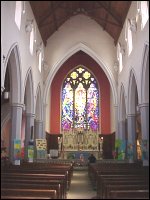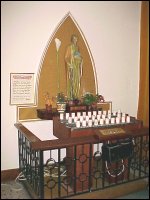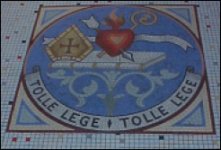Contenuto
Percorso : HOME > Monachesimo agostiniano > Conventualismo > Monasteri > Irlanda > GalwayConventi agostiniani IRLANDESI: Galway

Interno della chiesa

Altare di St. Agostino
IL CONVENTO E LA CHIESA DI GALWAY
History Of The Augustinians In Galway
Work began on the Augustinian foundation in Galway in 1500. It was located outside the city walls, on the same site as the present Forthill Cemetery. About the year 1546, outlawed by an edict of Henry VIII, the friars were deprived of their lands. From there the Augustinians moved to a site in Market Street. They were to spent the next one hundred years wandering between Forthill and various "safe havens" in the city. Not until 1760, according to the renowned historian James Hardiman, were they able to establish a public church near the site of the present one in Middle Street. Mass was celebrated continuously there - except for one single Sunday in Penal Times - until the 1850s. The foundation stone of the present Gothic Church was laid on August 28th, 1855.
James Hardiman was himself deeply involved in the project; indeed it was he who laid the foundation stone. Galway limestone, quarried from Angliham and Menlo quarries about two miles outside the city, was used in its construction. The church took four years to complete and its doors were first opened for public worship on September 4th, 1859. The spacious paved area, leading from the church steps, was created by Galway Corporation in the late 1980s. On the right stands a statue of Our Lady of Lourdes. The ornate crown on the statue was presented by a group of Galway ladies in 1923. The entrance area, with its new porch, dates from the reconstruction of the late 1970s. You will see the Augustinian crest on the Mosaic floor.
St. Augustine's Crest
Tolle Lege is the Latin phrase meaning "take up and read". This is a reference to the bible on the crest itself and is traditionally associated with the conversion of St. Augustine when he read Paul's Letter to the Romans, 13:13-14. The High Altar was erected in 1934 from a bequest of 7000, given by the mother of a Fr. Guiney O.S.A. from Athlone. Carved on the left panel as you face the altar is a scene from the life of St. Augustine. The death of Augustine's mother, Saint Monica, is depicted on the right panel. The oak panel surrounding the High Altar dates from 1855. The tabernacle dates from 1969. The mosaic on the floor of the sanctuary is, once again, the Augustinian crest. The altar rails were presented to the church by George Comyns Davenport and family, Rosshill, Co. Galway in the late 1920s. In the course of the 1970s renovations, the original window over the main altar was replaced by the stained glass representation of the Resurrection. The artist was one George Walsh from Dublin who completed the work in August, 1968.

Logo agostiniano
Shrines
To the right of the main altar is the Shrine to Our Lady of Good Counsel. A common feature in all Augustinian churches, this shrine was erected in the 1940s by the then prior, Fr. Farragher. Over the entrance to the sacristy is a statue of St. Augustine. To the left of the main altar is the shrine of the Sacred Heart. The stained glass window to the left of the shrine has a representation of St. Augustine. It too is the work of George Walsh. Unusually, Augustine is shown holding a quill in his left hand. Located mid-way down the church are two shrines to two famous Italian Augustinian saints, St. Nicholas of Tolentine (Feast Day September 10th) and St. Rita of Cascia (Feast Day May 22nd). The two shrines at the back of the church, to St. Joseph and the Pieta, date from the foundation of the church itself. The Pieta was donated by Mr. and Mrs. Kelly. On the left side is a shrine to St. Jude, recently erected.
Shrine To St. Jude
The Organ
This was constructed and installed by the famous Dublin organ builder, William Telford in 1868. It is valued today at 150,000. It was renovated, cleaned and reconstructed by Paul Neiland and Associates in 1992.
The Ceiling
The ceiling is of cedar wood and dates from the 1970s when the church was re-roofed and raised above the original (and still visible) roof supports. The Stations of the Cross were originally oak-frame and were presented by members of Old Galway Tribal families when the church was originally built.

